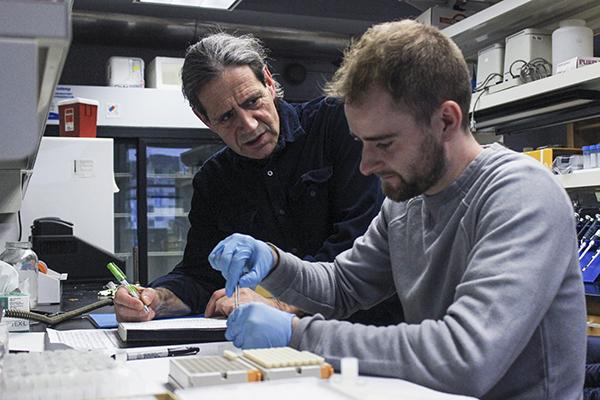Updated: Feb. 21, 2016 at 3:37 p.m.
Tucked away in Bell Hall, tiny test tubes filled with fish tissue lie in labs, waiting for researchers working to categorize thousands of fish species.
Guillermo Orti, a professor of biology, is bringing together five institutions around the world to categorize 35,000 species of fish. Orti collaborated with other GW researchers to secure a five-year, $2.5 million grant from the National Science Foundation for the project at the end of last year.
Orti said the project has researchers at institutions across the world, from the Smithsonian Institution to the University of Puerto Rico, who came together at GW in December to develop a game plan for their research. Orti said they will be categorizing fish species in their labs to map the evolution of the different species.
The researchers determine the fish species by taking tissue and extracting DNA before sending it off to a company that gives them back DNA sequences, Orti said. He added that he has two undergraduate students and three graduate students working in his lab.
Orti said scientific knowledge is enhanced by working with other researchers, and each researcher builds on one another to make new discoveries.
“That is why there is very strong emphasis with depositing all of this information into public, unified databases that anybody can understand and interpret,” Orti said. “We are well-connected, which is why we got funded.”
Keith Crandall, the director of the Computational Biology institute and one of the researchers involved with the grant, said the results from this project will add onto his previous research.
Crandall became director of the institute in 2012 and brought with him a $350,000 grant to assemble a “Tree of Life” database. Last year, Crandall and fellow researchers published the first draft of the tree of life which links the evolutionary history of 2.3 million named species.
Crandall said that the Tree of Life grant will end this year and he will soon meet with his NSF program officer to hopefully develop continuation plans. He said that until then he will be working with Orti to include the fish species into the Tree of Life database.
“In the meantime, we also are developing other projects that utilize that software and continue its productivity. One of those that just got funded was a fish GoLife project,” Crandall said.
The FishLife grant falls under the NSF Genealogy of Life program, or “GoLife,” which is designed to award projects that study the evolutionary relationships of organisms. At the end of last year, NSF awarded $12.3 million in grants to the program, and a portion went to Orti’s fish project.
Orti said this grant is the “gold standard” because it’s one of the largest awards that the NSF offers. He said this was his second attempt applying for this grant, which made the 194-page-long application seem more manageable.
“For me, it is just great. For the institution, it is just great because we are right there at the top,” Orti said.
Orti said his two freshmen undergraduate students will be in charge of getting photographs of the fish species at museums.
“It is not just a picture of a guy who pulled a fish out of the water,” Orti said. “You can focus on little groups or focus on the total tree with thousands of species. That is why we need the photographs to be able to map this.”
Along with the Tree of Life, Orti said he will be developing “Fish Snap,” or a phone application that will use recognition software to detect the species of fish in a smartphone picture.
“If you are in the field and pull a fish out of water, take a picture and the app will tell you what the species is,” he said.
Jeremy Goecks, an assistant professor of computational biology who is also working on the project, said in an email that he was tasked with a computational approach to break down the DNA and data they are collecting on the fish.
Goecks said that his goal is to apply his data collection expertise to “answer interesting questions about how different traits evolved in fish and build an evolutionary tree for fish.”
This post was updated to reflect the following correction:
The Hatchet incorrectly reported that Guillermo Orti was working with a Ph.D student named Andrew Thompson. Orti is working with Ashton Smith, a Smithsonian lab technician. We regret this error.







